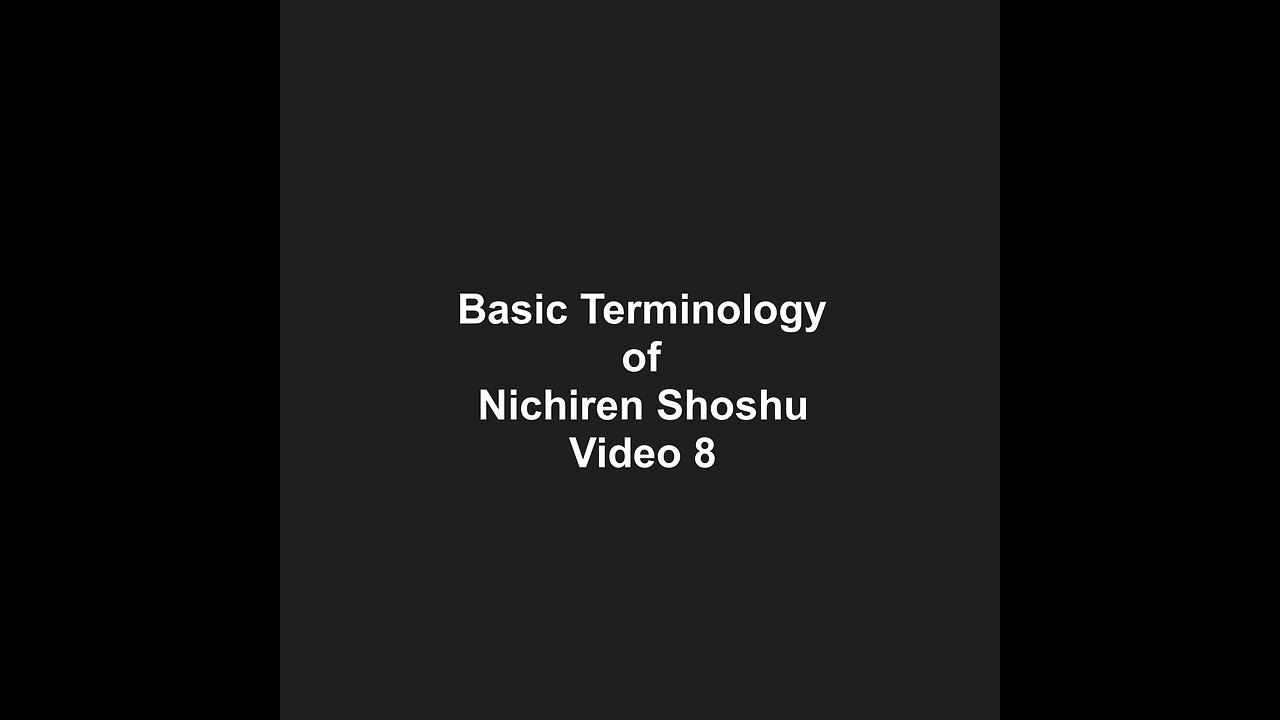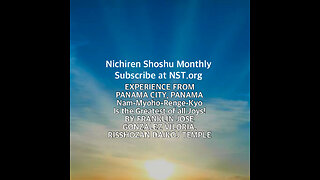Premium Only Content

Basic Terminology of Nichiren Shoshu Video 8
Basic Terminology of Nichiren Shoshu Video 8
FOUR STAGES OF RISE AND FALL
四重の興
(Shijù no kohaii
FOURTEEN SLANDERS
十四誹謗
(Jushi hibò)
FROM THE CAUSE OF PRACTICE TO THE EFFECT OF BUDDHAHOOD AND FROM THE TRUE EFFECT OF BUDDHAHOOD
TO THE TRUE CAUSE OF PRACTICE
從因至果• 果向因
(Juin shika, Juka köin)
FUSION OF OBJECTIVE REALITY AND SUBJECTIVE WISDOM
境智冥合
(Kyochi myogò)
Nichiren Shoshu is the orthodox school of Nichiren Buddhism.
I am a practicing lay person with Nichiren Shoshu since 1974.
I post doctrine for study.
To find a Nichiren Shoshu Temple in your area see http://www.NST.org
You can also contact any Temple to purchase books.
ONLY PRACTICING APPROVED LAY MEMBERS CAN DONATE.
Nichiren Shoshu is one if not the only religious practice that only accepts donations from practitioners.
My music and books can be found at http://www.Femaleslive.com
On Truth I am https://truthsocial.com/@USABuddhism
On IG http://www.instagram.com/johncharlesharman
I write fun and interesting articles, no politics, on Vocal ttps://vocal.media/authors/john-charles-harman-oabp6e0zmt
We call it True Buddhism because it is the teaching of the ultimate truth.
This truth was expounded 3000 years ago in Shakyamuni Buddha’s highest teaching, the Lotus Sutra. In this sutra, Shakyamuni explained that his Buddhism would benefit people for 2000 years after his death, but after that, the people would no longer be able gain any merit from his teachings. He predicted the advent of the True Buddha who would reveal the teaching whereby all the people in the world could purify their lives and attain the highest life condition, enlightenment or Buddhahood.
On February 16, 1222, Nichiren Daishonin, the True Buddha of this time period which we call the Latter Day of the Law, made His advent in Japan. He fulfilled all of the predictions made in the Lotus Sutra, and established the teaching of True Buddhism which will lead the people to happiness. On October 12, 1279, he inscribed the fundamental Object of Worship, called the Dai-Gohonzon. The object of worship is a transcription of the Dai-Gohonzon, transcribed by the High Priest of Nichiren Shoshu.
The Gohonzon is the entity and manifestation of the enlightened life of the True Buddha. Our goal is to fuse with this Gohonzon when we do our daily prayers and recitations so that our own Buddha nature will come forth from the depths of our lives. All of us, the members of Nichiren Shoshu, have a smaller Gohonzon enshrined in an altar in our own homes so we can do our daily practice to it.
Our daily practice consists of a primary and a supporting practice.
The primary practice is to chant Nam-Myoho-Renge-Kyo to the Gohonzon. Nam-Myoho-Renge-Kyo is the seed of Buddhahood, the life of the True Buddha, and the Law to which He is enlightened.
The supporting practice is to do morning and evening Gongyo. Gongyo is the recitation of part of the second and all of the sixteenth chapter of the Lotus Sutra together with silent prayers. This is exactly what we do at home each morning and evening.
There are two types of benefit we receive when we chant Nam-Myoho-Renge-Kyo and do Gongyo in front of the Gohonzon. They are conspicuous benefit and inconspicuous benefit. When we see a quick and obvious response to our prayers it is easy to see the cause and effect relationship between chanting Nam-Myoho-Renge-Kyo and seeing a benefit in our lives. This is called conspicuous benefit.
However, if we practice this Buddhism over a long period of time, like a tree that grows slowly but surely, we can look back and realize that every aspect of our life has dramatically improved. This is inconspicuous benefit.
Since everyone is different, each one of us will receive different types of benefits that will show us that this Buddhism is true. The ultimate goal is for us to achieve the highest life condition of enlightenment, with profound wisdom, indestructible happiness, and the power to overcome all obstacles and difficulties that we may face. At the same time, our practice is not apart from the realities of daily life. If you practice True Buddhism, you will get benefit.
This teaching is based on actual proof. Our practice of Buddhism also has two aspects—practice for oneself and practice for the sake of others.
Practice for oneself is chanting Nam-Myoho-Renge-Kyo, doing morning and evening Gongyo, coming to the ceremonies at the Temple and local meetings, and studying the teachings of Buddhism.
Practice for the sake of others is telling other people about Nichiren Shoshu Buddhism and helping them learn how to practice. This is called Shakubuku.
The True Buddha, Nichiren Daishonin, gave us two important goals. The first one is for us to attain our own enlightenment. The second is for us to widely spread this Buddhism so that we can have a peaceful and happy world where the people and the land are truly purified. This is called kosen-rufu.
Since Buddhism is based on actual proof, we encourage you to start chanting and see for yourself the benefit you can experience in your life.
THERE HAS NEVER BEEN A MAJOR WAR IN THE NAME OF TRUE BUDDHISM OR BECAUSE THE FOCUS IS ON INDIVIDUAL ENLIGHTENMENT.
-
 14:05
14:05
Nichiren Shoshu True Buddhism
2 months agoEXPERIENCE FROM PANAMA CITY, PANAMA
1003 -
 3:02:18
3:02:18
Barry Cunningham
5 hours agoBREAKING NEWS: PRESIDENT TRUMP THIS INSANITY MUST END NOW!
82.9K156 -
 3:58:27
3:58:27
StevieTLIVE
4 hours agoWednesday Warzone Solo HYPE #1 Mullet on Rumble
29.6K -
 5:58
5:58
Mrgunsngear
6 hours ago $2.88 earnedBreaking: The New Republican Party Chairman Is Anti 2nd Amendment
23.2K8 -
 2:28:35
2:28:35
Geeks + Gamers
5 hours agoGeeks+Gamers Play- MARIO KART WORLD
24.6K -
![(8/27/2025) | SG Sits Down Again w/ Sam Anthony of [Your]News: Progress Reports on Securing "We The People" Citizen Journalism](https://1a-1791.com/video/fww1/d1/s8/6/G/L/3/c/GL3cz.0kob.1.jpg) 29:34
29:34
QNewsPatriot
6 hours ago(8/27/2025) | SG Sits Down Again w/ Sam Anthony of [Your]News: Progress Reports on Securing "We The People" Citizen Journalism
18.5K2 -
 25:12
25:12
Jasmin Laine
10 hours agoDanielle Smith’s EPIC Mic Drop Fact Check Leaves Crowd FROZEN—Poilievre FINISHES the Job
22.3K23 -
 11:33:26
11:33:26
ZWOGs
14 hours ago🔴LIVE IN 1440p! - SoT w/ Pudge & SBL, Ranch Sim w/ Maam & MadHouse, Warzone & More - Come Hang Out!
12.5K -
 2:35:34
2:35:34
This is the Ray Gaming
3 hours ago $0.15 earnedI'm Coming Home Coming Home Tell The World... | Rumble Premium Creator
7.43K -
 9:42:31
9:42:31
GrimmHollywood
13 hours ago🔴LIVE • GRIMM HOLLYWOOD • GEARS OF WAR RELOADED CUSTOMS • BRRRAP PACK •
8.38K